Pest Control
Protecting Your Crops Without Poisoning Them
Gardens and orchards are threatened by three enemies: disease, insects, and animals. During the last few decades the standard defense agains most of these pests has been massive doses of man-made poisons. For large-scale farmers there may be no practical alternative, but the home gardener has an arsenal of nonchemical and organic methods from which to choose.
Some are as simple as picking pests off plants by hand or employing basic preventive hygiene to keep them from breeding; others are as sophisticated as electronic traps that lure insects then electrocute them. Some strategies enlist the aid of nature herself to fight pests by encouraging natural predators or cultivating pest-repellent plants near valued crops. Fences bar the larger animals, while traps and barriers defend against a variety of insects and small animals. As a last resort there are organic sprays and dusts— naturally occurring insecticides usually derived from plants.
The underlying theme of natural pest control is the recognition that a garden or orchard is part of an ecological whole and that the entire system must be in balance for the garden or orchard to be healthy. Those who practice ecological gardening do not try to eliminate pests completely, since in so doing they will eliminate the food supply of many beneficial organisms. Instead, the aim of organic pest control is to keep the number of pests low enough so that they do not do serious damage while at the same time maintaining the predator population that feeds on the pests.
Nonchemical controls entail more time and labor than chemical methods, and the nonchemical gardener must be prepared to lose some crops to “bugs.” But an increasing number of people find this a price worth paying.
A Rogue's Gallery of Common Insect Pests
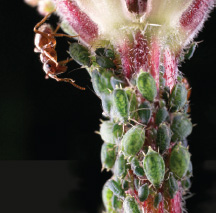
Aphids are probably the most common garden pests. They suck sap from leaves and stems, weakening plants. They also spread virus and fungal diseases.
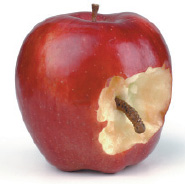
Codling moth larvae are serious pests to apples. They tunnel their way into the hearts of young fruits, emerging on the far side and leaving worm holes behind.
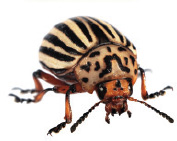
Colorado potato beetles attack potatoes, eggplant, tomatoes, and peppers. The adults and larvae both devour foliage and may kill entire plants if unchecked.
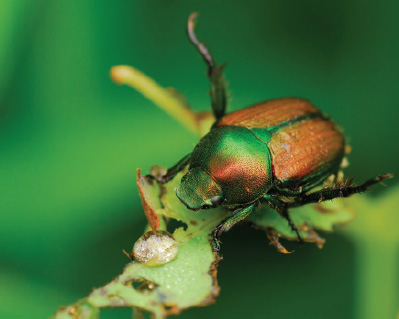
Japanese beetles feed on leaves of fruit and shade trees and also destroy much fruit directly. The larvae, which feed on the roots of grass, are major lawn pests.
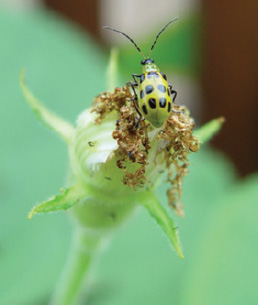
Spotted or Striped cucumber beetles feed on every part of cucumber plants, including the roots, and spread bacterial wilt. They also attack squash, melons, beans, peas, and corn.
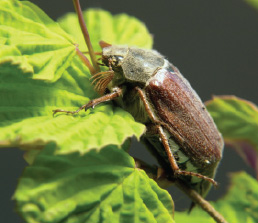
June beetles (also called May beetles in some locations) can cause extensive damage to the roots of lawns and shrubs.
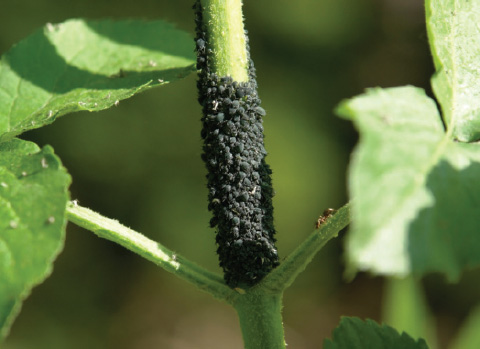
Plant louses feed on plant juices and can damage both indoor and outdoor plants.
Using Natural Controls
One of the easiest ways to combat pests is to protect and encourage such natural allies as birds, toads, spiders, nonpoisonous snakes, and insects that feed on other insects. In many cases this simply involves no more than tolerating the predator (such as a snake or spider) instead of killing it or destroying its habitat. With a little more effort you can provide suitable habitats for insect destroyers; for example, an inverted flower pot for toads or a special birdhouse for purple martins (see Living With Nature, p.445). Another solution is to stock your garden or orchard with beneficial insects. Ladybug and praying mantis eggs are sold by many garden supply houses; both insects prey on a variety of common pests. Another natural predator is the trichogramma wasp, which lays its eggs inside the eggs of many species of caterpillar. The wasp larvae feed on caterpillar eggs, destroying them.
The introduction of specific insect diseases is a proven biological method of pest control. Milky spore disease, available as a white powder, can be dusted on the soil to infect and kill the larvae of the Japanese beetle. Bacillus thuringiensis—BT for short—is a bacterium that infects many destructive caterpillars, including the cabbage worm and gypsy moth. It is applied as a spray and has an effective life of seven days. Both milky spore and BT are harmless to humans, domestic animals, and such beneficial insects as honeybees.
More sophisticated biological controls have been developed, although as yet they are practical for large-scale use only and are therefore beyond the scope of the home gardener. One such method is the rearing and release of huge numbers of sterile male insects. By competing with normal males in mating, these sterile insects reduce the number of offspring. Another technique is to spray caterpillars with juvenile hormones; the caterpillars never mature to have young, cutting down tremendously on the size of the next generation.
So-called trap crops take advantage of the food preferences of various insect pests by luring them away from more valuable crops. For example, nasturtiums lure aphids away from nearby vegetables, while Japanese beetles are attracted to white geraniums, white or pastel zinnias, and odorless marigolds. Radishes lure root maggots away from cabbage crops, eggplants draw flea beetles away from potato plantings, dill attracts tomato hornworms, and mustard greens are a good trap crop for harlequin bugs. Pests concentrated on the trap crop can be picked off by hand and destroyed, but this must be done regularly or the trap crop will not be effective. Kill the pests by dropping them into kerosene or into water that has a thin layer of kerosene on it.

Natural predators are one of the gardener's most powerful weapons predators that feed on insect pests are shown above. All are harmless for fighting pests; moreover, they require no care and need only to humans and should be encouraged in your garden, berry patch, be left alone to do their work. Some of the more commonly found or orchard.
Preventive measures stop trouble before it starts
Gardens, like human beings, can be kept healthy and productive more cheaply and more easily with an ounce of prevention than with a pound of cure.
Prevention begins with the soil. Till your garden in the autumn as well as spring to expose subsoil insects and larvae to predators and the weather. Since well-nourished plants have greater resistance than poorly nourished ones, keep the soil's organic content high. Compost, organic mulches, and well-rotted manure are excellent additives.
Sanitation is a simple but effective preventive technique, useful against both disease microorganisms and insect pests. Locate your garden in a spot with good drainage and air flow; quick drying discourages fungi. Disease organisms can be kept from spreading from sick plants to healthy ones by removing all sick plants from the garden, the orchard, and the surrounding area. The diseased materia should be burned or buried—do not use it for compost. Branches and canes pruned from fruit trees, bushes, and vines should be disposed of in the same way. If they are eft on the ground near plants, they can act as breeding grounds for boring insects and fungus disease. Fallen fruit should be picked up twice a week and buried or fed to livestock. Vegetable plants should be removed from the garden at the end of the growing season. They can safely be composted in a fast-acting compost pile (see The Kitchen Garden, p.132).
Crop rotation is an effective measure, especially against soil-borne disease. By shifting a crop to a new area yearly, pathogens and pests that may have developed the previous year are deprived of their host. In a small garden it may be difficult to rotate crops, but the same effect can be gained by changing the type of vegetables planted. For example, if squash is grown one summer, plant a member of a different family the next. If you are fond of a certain vegetable, plant different varieties each year and concentrate on pest-resistant strains.
Do-it-yourself Defenses For Foiling the Enemy
Repellents are often effective in deterring pests, thereby protecting crops without having to resort to poisons. Many gardeners report success with homemade sprays based on hot peppers, onions, and garlic. As with poison sprays, add a few drops of liquid detergent or 1/3 cup of soap flakes per gallon of spray to increase the spray's sticking power and effectiveness. Another type of repellent spray is made by liquifying the pests in a blender. It is said to be effective on slugs, snails, and insects, but each liquified pest repels its own species only.
Some plants are natural repellents. Mints and other aromatic herbs interplanted with vegetables discourage a number of insects, especially those that attack the cabbage family. Radishes have been successful in repelling pests of melons and other vine crops. Garlic is one of the most potent repellent plants and will protect nearby fruit plantings from Japanese beetles and aphids. If planted around fruit trees, it is said to keep borers away. (For more information on companion planting, see The Kitchen Garden, p.126.)
Tar paper repels cutworms by its odor. Use 3-inch squares of tar paper laid on the ground, with holes in the centers for the stems to pass through, to protect seedlings from these pests. Aluminum foil laid on the ground has been found to be effective against aphids and squash-vine borers. Plants also appear to benefit from the extra reflected light. A simple way to remove aphids from foliage is to knock them off with a jet of water from the garden hose; few return to the plants.
There are a number of botanical poisons—natural chemicals produced by plants for their own protection— that are deadly to many insects but virtually harmless to humans and other warm-blooded animals. These substances break down into harmless by-products soon after use. The best known are ryania, rotenone, and pyrethrum. Nicotine, another powerful natural insecticide, is very dangerous to humans, animals, and bees.
Diatomaceous earth is a different sort of pesticide, working mechanically rather than chemically. It is sold as a fine dust made up of the skeletons of tiny one-celled sea organisms. The dust particles have sharp spikes that pierce the skins of such soft-bodied insects as aphids, causing them to die of dehydration.
Harmless pest killers can be made from a number of common household substances. A safe old-time remedy for cabbage worms is to sprinkle flour on the developing cabbage heads. The worms ingest the flour, which swells up inside them and bursts their intestines. Finely powdered sugar sprinkled on the plants can kill cabbage worms by dehydration. Salt sprinkled on slugs causes them to exude masses of orange slime and die. Insect eggs on the bark of trees can be smothered by painting the bark with a mixture of old cooking oil and soapy water during the dormant season—a homemade variation on the standard dormant spray. A good dormant spray can also be made by adding one part superior oil (sold in garden stores) to 15 parts water. No detergent is needed to emulsify superior oil. (Vegetable oil can be used instead, but it needs an emulsifier.)
Countering the common insect pests
| Pest | Control |
| Aphid | Spray with dilute solution of clay or quassia extract; soapy water is also effective, but be sure to rinse off plants immediately after application (kills) |
| Cabbage worm, imported | Apply sour milk in the center of the cabbage head (repels). Or dust with a mixture of ½ cup salt to 1 cup flour (kills) |
| Codling moth | Spray with ryania, fish oil, or soapy water (kills) |
| Colorado potato beetle | Dust plants with wheat bran while they are wet (kills). Or pick off by hand |
| Corn earworm | Apply mineral oil to the silk just inside the tip of each ear—use a medicine dropper or small oil can (repels) |
| Flea beetle | Dust with soot mixed with slaked lime or wood ashes (repels). Or spray with rotenone (kills) |
| Harlequin bug | Spray with pyrethrum (kills) |
| Mexican bean beetle | Spray with garlic or cedar extract (repels) |
| Tarnished plant bug | Dust with sabadilla, an organic insecticide (kills) |
| Thrips | Spray with rotenone, oil-water mixture, or tobacco extract (kills) |
Formulas You Can Make at Home
Homemade pesticides and repellents tend to be safer than synthetic substances in terms of undesirable side effects. Nevertheless, they should be treated with respect. Wash fruits and vegetables before eating them, and use the sprays as sparingly as possible to avoid unnecessary ecological damage.
Biodynamic spray. Mix powdered clay and an organic insecticide such as rotenone with enough water to make a thin fluid. Spray on fruit trees in early spring before leaves appear to suffocate eggs of insect pests.
Buttermilk and flour spray. Mix ½ cup buttermilk and 4 cups wheat flour with 5 gallons of water; kills spider mites and other mites by suffocation.
Cedar extract. Boil ¼ pound cedar chips or dust in 1 gallon of water for two hours; strain and dilute the liquid with three parts water; spray on plants to repel Mexican bean beetles and other troublesome beetles.
Garlic and hot pepper spray. Steep ½ teaspoon each of crushed garlic and crushed hot peppers in 1 gallon of water for 10 to 24 hours. Use full strength on woody plants; dilute 25 percent for annuals and vegetables. Spray repels many sucking and chewing insects.
Glue mixture. Dissolve ¼ pound of fish or animal glue in 1 gallon of warm water. Spray trees and bushes to trap and kill aphids, spider mites, and scale insects. (It removes pests from trees when it flakes off on drying.)
Green soap spray. Mix 1 cup of green soap tincture with 3 gallons of water; kills nonfurry caterpillars on contact. Green soap is available in drugstores. Laundry soap can be used instead in the ratio of ½ cake of soap to 1 gallon of hot water. If used on nonwoody plants, rinse off with clear water immediately after applying.
Quassia spray. Boil ¼ pound of quassia chips in 1 gallon of water for two hours, strain the liquid, and mix with three to five parts water. The spray poisons aphids and caterpillars but is harmless to ladybugs and bees.
Homemade organic sprays can also be made from infusions of larkspur seeds, rhubarb leaves, or tobacco. Such sprays are nonpersistent and are effective against a variety of insect pests—larkspur against aphids, thrips, and several species of chewing insects; rhubarb against aphids; tobacco against a wide assortment of soft-bodied insects. However, these preparations are highly poisonous to humans and animals. If you do use them, be sure to wash the produce thoroughly before eating it.
Traps and Barriers
Proper fencing and netting will protect fruits and vegetables against most of the larger animals, including deer, rabbits, raccoons, woodchucks, dogs, and birds. Raccoons can be a bother because of their ability to climb, but extra-high chicken wire or an electric fence line across the top will discourage them. Some simple yet effective barriers are shown at right.
Many of the smaller common garden pests can be caught in simple traps. A shallow pan filled with beer is deadly to slugs and snails: the odor of the beer lures the mollusks into the pan where they drown. Using flour to thicken the beer will increase its effectiveness.
Aphids are attracted by the color yellow. Fill a yellow plastic dishpan with a solution of soap and water and place it near infested plants. Other containers, such as a 5-gallon oil can, can be used; paint the inside bright yellow (the outside can be any color other than red, which repels aphids). Japanese beetles are also attracted by yellow. An effective Japanese beetle trap is a yellow container with a scent lure, such as geraniol or oil of anise. Another Japanese beetle trap consists of a glass jug containing an inch or two of a fermenting “soup” of water, sugar, and mashed fruit scraps. Japanese beetle traps should be placed well away from your plants, since they attract beetles from a wide area.
Codling moths, apple maggot flies, and many other flying orchard pests can be trapped in empty tin cans or glass jars filled with a mixture of one part molasses and 1 ½ parts water, plus a little yeast. Hang the traps in the fruit trees when the moths or flies appear. To catch earwigs, use rolled-up newspapers or hollow bamboo tubes. The insects will seek shelter in the tubes toward evening. Shake them out into kerosene each morning.
Caterpillars can be trapped by smearing bands of Tanglefoot, a sticky commercial preparation, around the trunks of fruit and other trees. Experimenters have also found that destructive flying insects can be trapped on colored spheres 3 to 6 inches in diameter, hung from the trees and coated with Tanglefoot or homemade flypaper stickum (see Household Recipes, p.343). Construct the spheres of any lightweight material, such as small gourds or styrofoam, and paint them orange, dark red, or black.
The tomato hornworm and other destructive caterpillars, such as the armyworm, cutworm, peach borer, and corn earworm, are actually larvae. The moths are easily caught at night in traps that use an ultraviolet bulb to lure the moths into a container. Another version of this type of trap has an electric grid around the bulb that kills the insects on contact. Check such traps regularly; if too many beneficial insects are being caught, discontinue their use.

Fencing, barriers, and traps prevent pests from reaching valuable free if set up properly. Many traps can be made at home from scrap crops. Fencing can be costly but is long-lasting and relatively trouble materials. All avoid the use of harmful chemicals.
Sources and resources
Books and pamphlets
DeBach, Paul. Biological Control of Natural Enemies. New York: Cambridge University Press, 1974.
Pleasant, Barbara. The Gardener's Bug Book: Earth Safe Insect Control. Pownal, Vt.: Storey Communications, 1994.
Yepsen, Roger B., Jr. The Encyclopedia of Natural Insect and Disease Control. Emmaus, Pa.: Rodale Press, 1984.
Sources of natural controls
Fairfax Biological Laboratory. Clinton Corners, N.Y. 12514 (milky spore disease).
Mellinger's, Inc. 2310 W. South Range Rd., North Lima, Ohio 44452.
Natural Pest Controls. Lexington Way, Sacramento, Calif. 95815.